Elevations and Locations
East Vosk River
This series is about that area along the east portions of the Vosk River. The image to the right shows the region - the west region is covered in another series. I am thinking to do the Voltai Range later as one series also.
The Eastern Vosk Region is very interesting because it covers so many different land types - from mountain to forest to field. There are numerous trails scattered through this are and it is the most documented area in the chronicles of Gor. Right clicking and opening the map will make it easier to see.
Ko-ro-ba lay in the midst of green and rolling hills, some hundreds of feet above the level of the distant Tamber Gulf and that mysterious body of water beyond it, spoken of in Gorean simply as Thassa, the Sea. Ko-ro-ba was not set as high and remote as for example was Thentis in the mountains of Thentis, famed for its tarn flocks, but it was not a city of the vast plains either, like the luxurious metropolis of Ar, or of the shore, like the cluttered, crowded, sensuous Port Kar on the Tamber Gulf. Whereas Ar was glorious, a city of imposing grandeur, acknowledged even by its blood foes; whereas Thentis had the proud violence of the rude mountains of Thentis for its setting; whereas Port Kar could boast the broad Tamber for her sister, and the gleaming, mysterious Thassa beyond, I thought my city to be truly the most beautiful, its variegated lofty cylinders rising so gently, so joyfully, among the calm, green hills.
An ancient poet, who incredibly enough to the
Gorean mind had sung the glories of many of the cities of Gor, had spoken
of Ko-ro-ba as the Towers of the Morning, and it is sometimes spoken of
by that name. The actual word Ko-ro-ba itself, more prosaically, is simply
an expression in archaic Gorean referring to a village market.
Outlaw of Gor Pg 39-40
Thus when the tarnsmen of Treve came to the grain fields of Ko-ro-ba,
which lie for the most part some pasangs from the city, toward the Vosk
and Tamber Gulf, they would find her tarnsmen arrayed against them.
Priest-Kings of Gor Pg 62
I shrugged. Much of Gor was terra incognita. Few knew well the lands on
the east of the Voltai and Thentis ranges, for example, or what lay west
of the farther islands, near Cos and Tyros. It was more irritating, of
course, to realize that even considerable areas of territory above Schendi,
south of the Vosk, and west of Ar, were unknown.
Explorers of Gor Pg 16
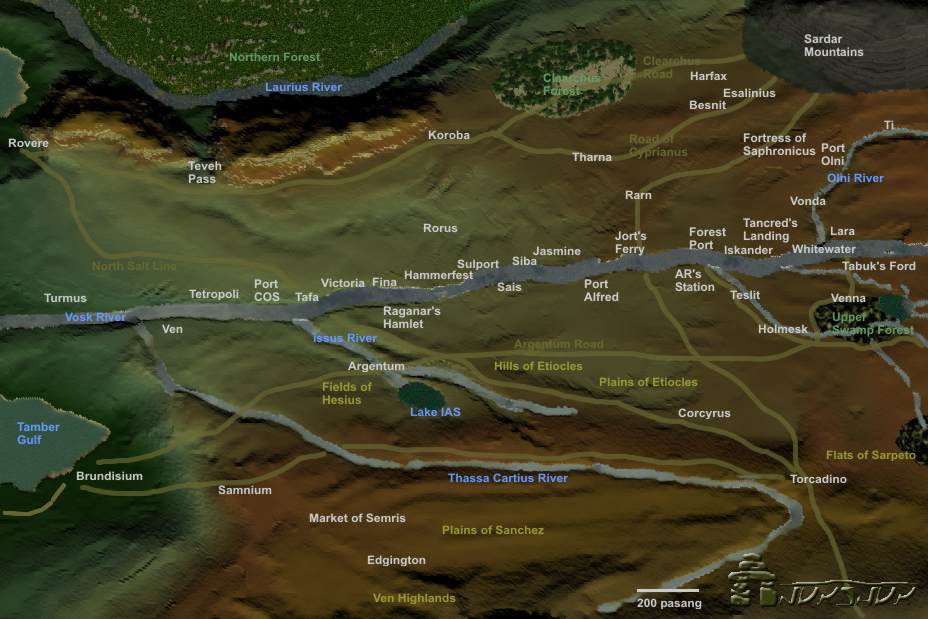
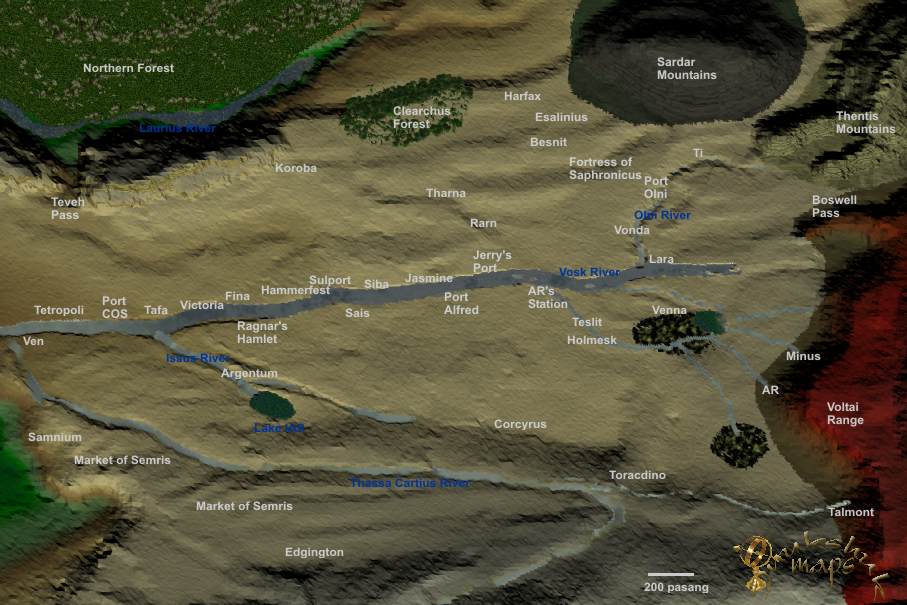
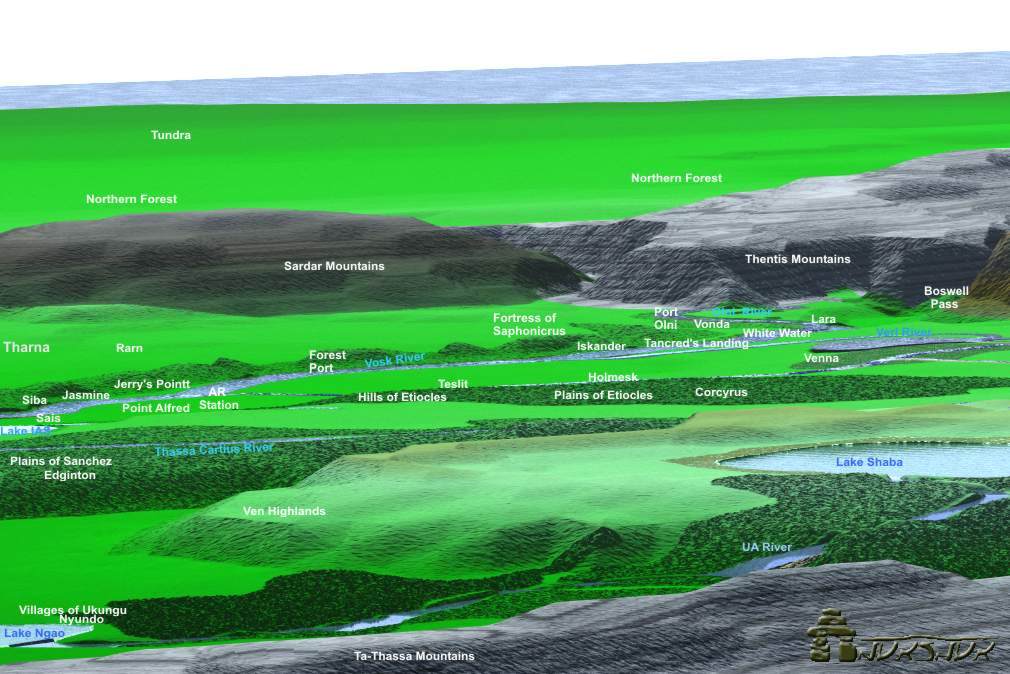
The region is characterized by the large amount of agricultural land used to grow sa-tarna grain. The yellow fields in the images are sa-tarna. The Clearchus Forest is present between the Sardar fair and Tharna / Koroba. Several of the trails are marked on the maps. AR itself sits at the base of the Voltai Range and overlooks the entire eastern Vosk Region.
There are several wooded areas including the Upper and Lower Swamp Forests. Near Corcyrus can be found the Plains of Etiocles and Torcadino lies south and east of it. The distance from the Sardar Mountains to Torcadino I would estimate to be about 1500 pasang or slightly more.
Scale is an important issue in this series. You will notice I fore-shortened distances by introducing taller trees. The Vosk River is large, much larger in reality than the trees, but I compromised the vegetation to provide an understanding of the vegetaiton. Later it will be scaled down.
Kailiauk is the easternmost town at the foot of the Thentis mountains. It lies almost at the edge of the Ihanke, or Boundary. From its outskirts one can see the markers, the feathers on their tall wands, which mark the beginning of the country of the red savages. Savages of Gor Pg 77
...In Kailiauk, as is not unusual in the towns
of the perimeter, the Administrator is of the Merchants. The major businiess
of Kailiauk is the traffic in hides and kaiila. It serves a function as
well, however, as do many such towns, as a social and commercial center
for many outlying farms and ranches. It is a bustling town, but much of
its population is itinerant. Among its permanent citizens I doubt that
it numbers more than four or five hunderd individuals....
Savages of Gor Pg 93-94
By order of Rask of Treve they, by their skill
in weapons and their mastery of the techniques and lore of the hunt, and
pretending to be of Minus, a village under the hegemony of Ar, made petition,
and successfully so, to participate in the retinue of the great Ubar....
Captive of Gor Pg 15
He had won her in Girl Catch, in a contest to decide a trade dispute between
two small cities, Ven and Rarn, the former a river port on the Vosk, the
second noted for its copper mining, lying southeast of Tharna....
Beasts of Gor Pg 41
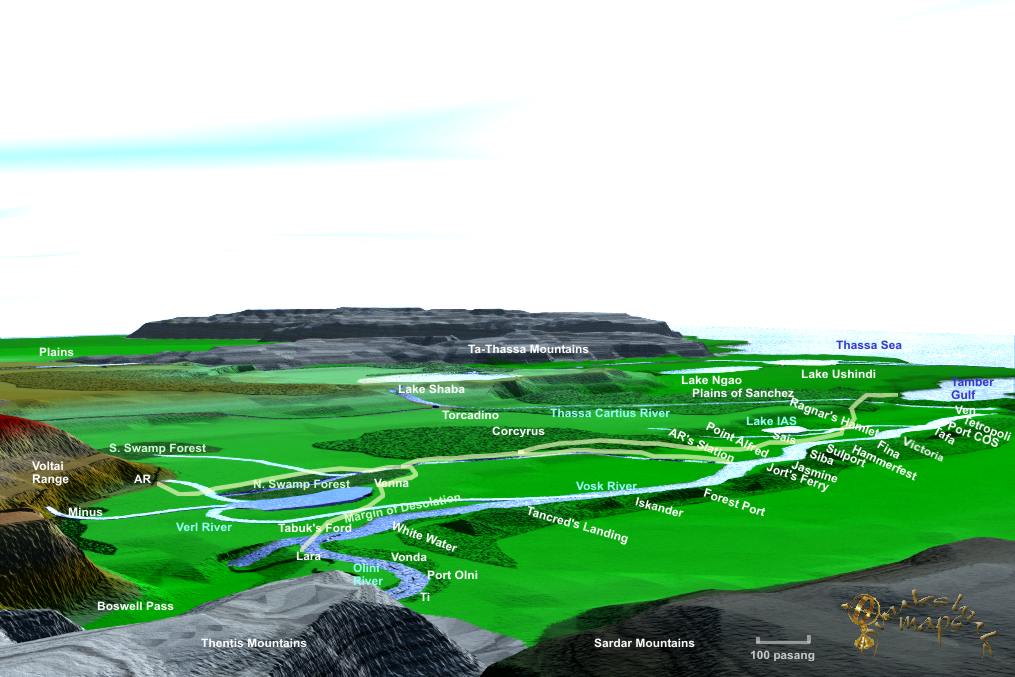
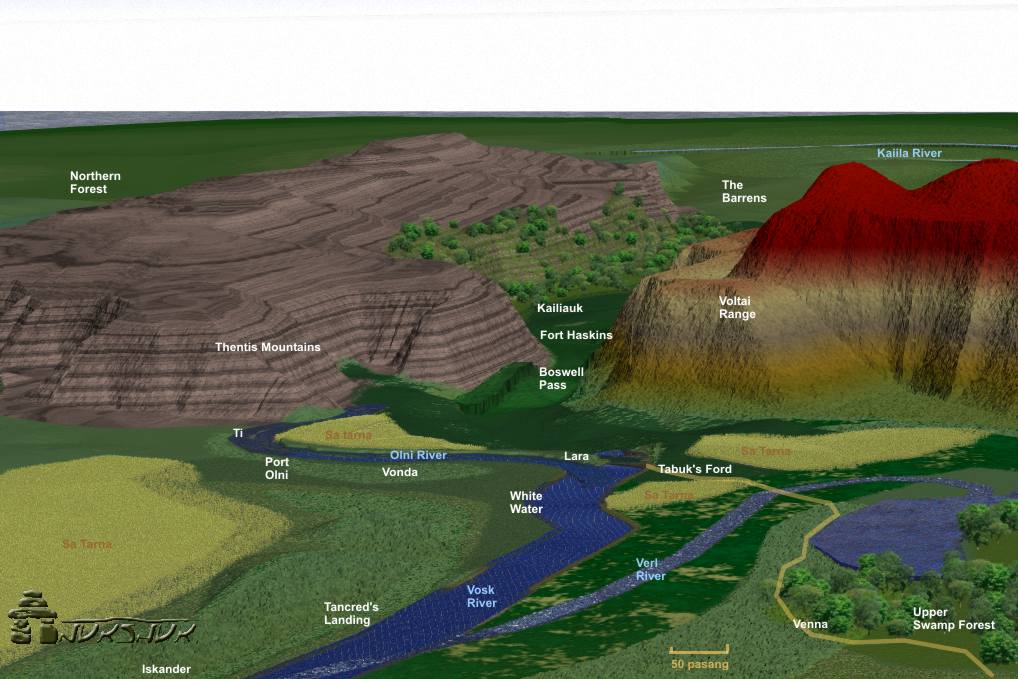
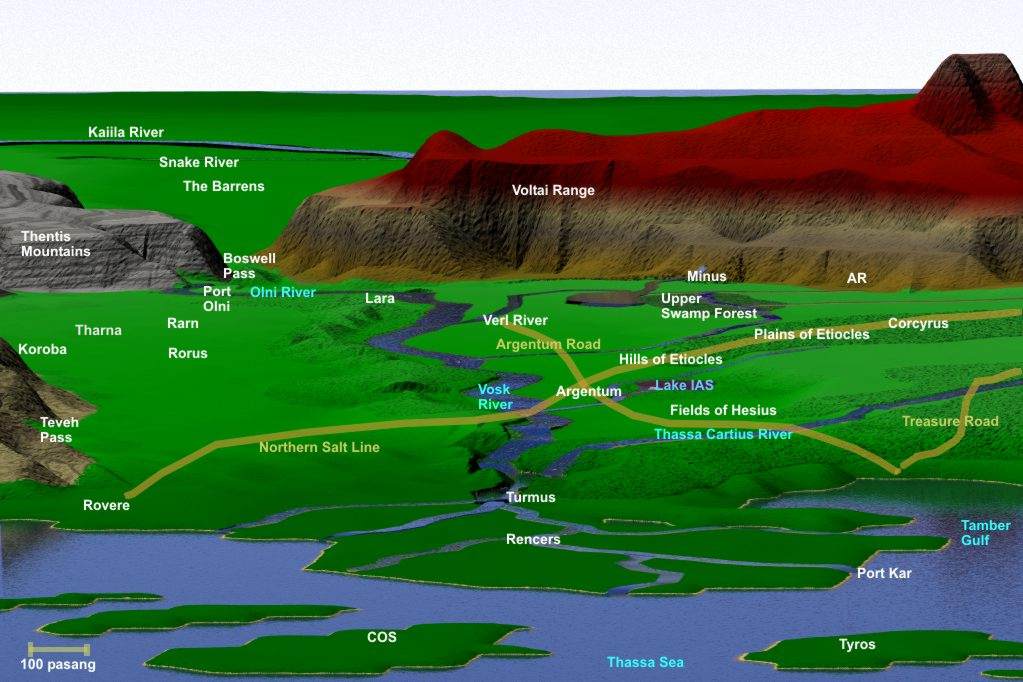
Slave Girl of Gor Pg 135
The girls of Clitus Vitellius, I among them, stood at the line scratched in the dirt within the peasant village of Tabuk's Ford, some four hundred pasangs to the north, and slightly to the west of Ar, some twenty pasangs off the Vosk road to the west. Slave Girl of Gor Pg 152
Vonda was one of the four cities of the Salerian
Confederation. The other cities of this confederation were Ti, Port Olni
and Lara. All four of these cities lie on the Olni River, which is a tributary
to the Vosk.
Fighting Slave of Gor Pg 171
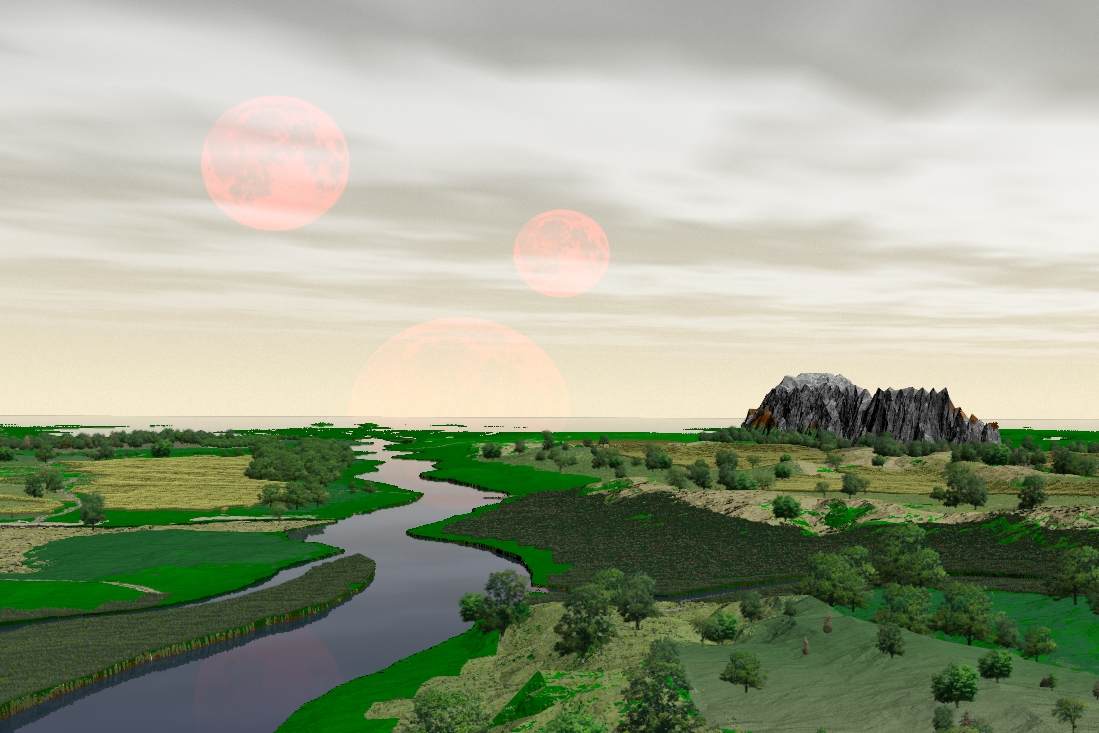
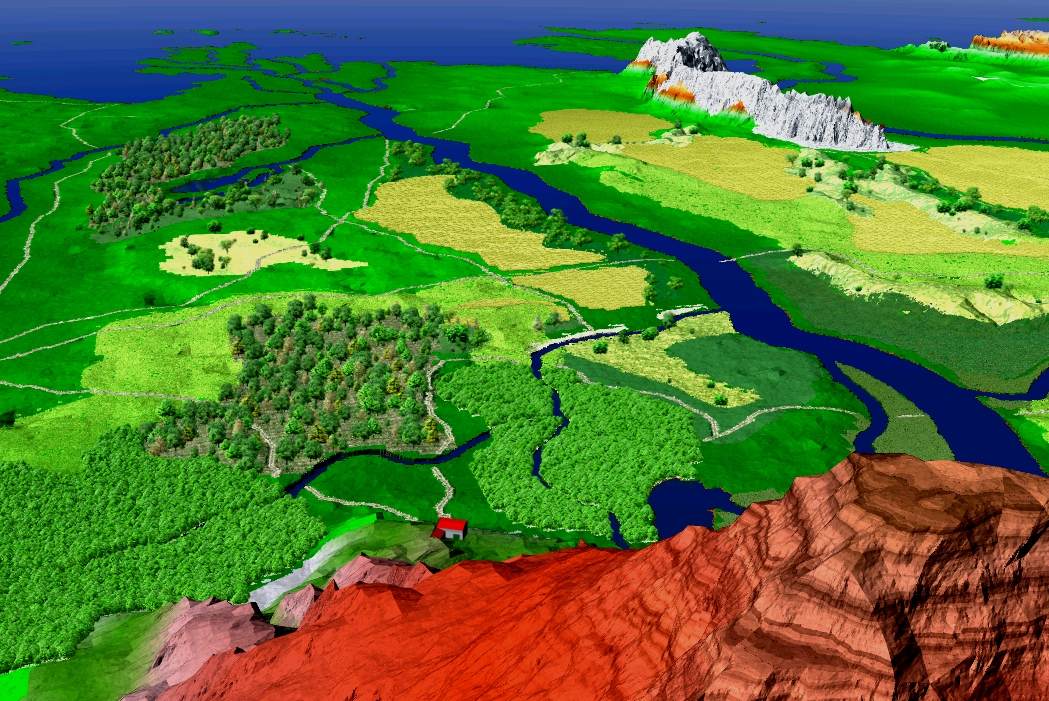
The Vosk River runs through the middle of the eastern region. Leading to many tributaries and smaller waterways, the Vosk is said to be 40 pasang wide. The Vosk River is shallow. usually barges plied the Vosk and smaller boats along the tributaries.
The Vosk is also known to freeze over at certain times of year. This it really is the start of the northern regions and vegetation changes just north of the Sardar Mountains - this will be seen in the Northern Forest series yet to come.
The Vosk is a mighty river which flows westward, emptying into a vast rence delta, finding its way eventually to Thassa, the sea....Slave Girl of Gor Pg 248, 10:248
There were many things supposedly strange about
Tharna, among them that she was reportedly ruled by a queen, or Tatrix,
and, reasonably enough in the circumstances, that the position of women
in that city, in contrast with common Gorean custom, was one of privilege
and opportunity.
Outlaw of Gor Pg 49
...These mines (those of Argentum) were said to
be almost as rich as those of Tharna, far to the north and east of Corcyrus....
Kajira of Gor Pg 89
...In that revolution the gynocracy in Tharna
had been overthrown, devastatingly. Even to this day women in Tharna are
kept almost uniformly as helpless, abject slaves, the men of Tharna having
an excellent memory for history....
Vagabonds of Gor Pg 267
The Older Tarl had told me that Thentis is a city
famed for its tarn flocks and remote in the mountains from which the city
takes its name.... Tarnsman of Gor Pg 67
The Sardar Mountains, which I had never seen, lay more than a thousand
pasangs from Ko-ro-ba. Whereas the Men Below the Mountains, as the mortals
are called, seldom enter the mountains, and do not return when they do,
many often venture to their brink, if only to stand within the shadows
of those cliffs that hide the secrets of the Priest-Kings. Indeed, at
least once in his life every Gorean is expected to make this journey.
Outlaw of Gor Pg 47
On river barges, for
hundreds of pasangs, I had made my way down the Vosk, but where the mighty
Vosk began to break apart and spread into its hundreds of shallow, constantly
shifting channels, becoming lost in the vast tidal marshes of its delta,
moving toward gleaming Thassa, the Sea, I had abandoned the barges, purchasing
from rence growers on the eastern periphery of the delta supplies and
the small rush craft which I now propelled through the rushes and sedge,
the wild rence plants.
Raiders of Gor Pg 5
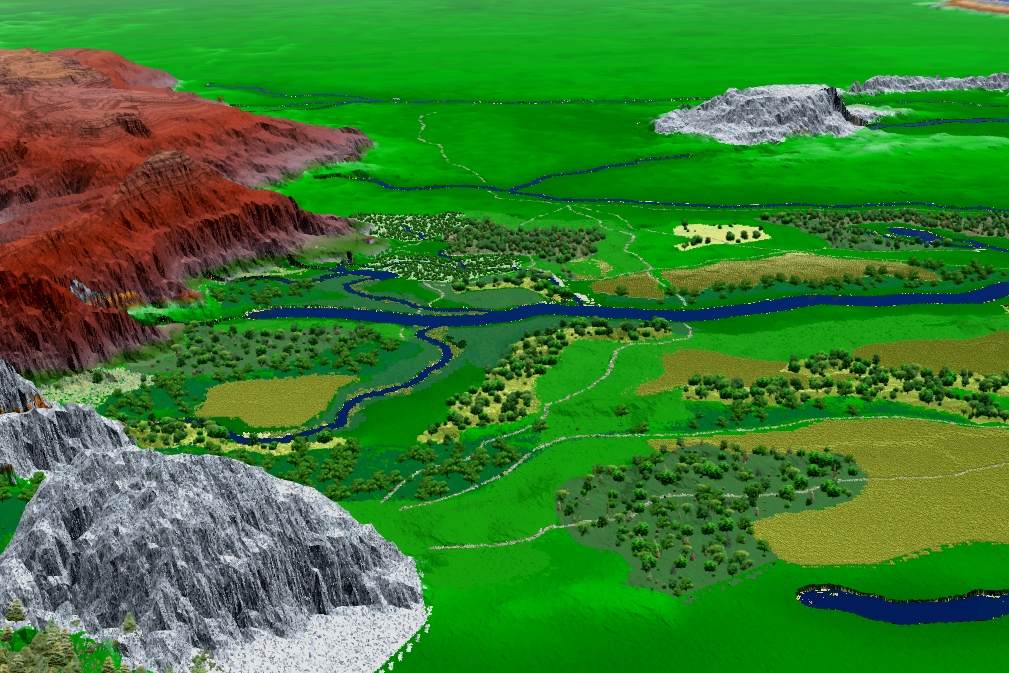
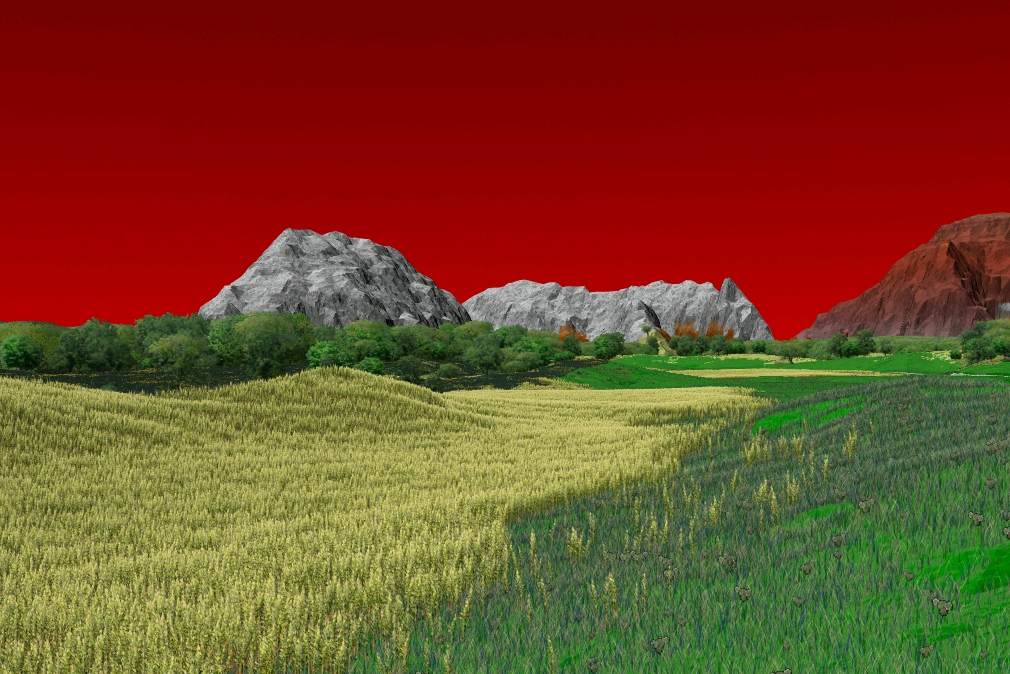
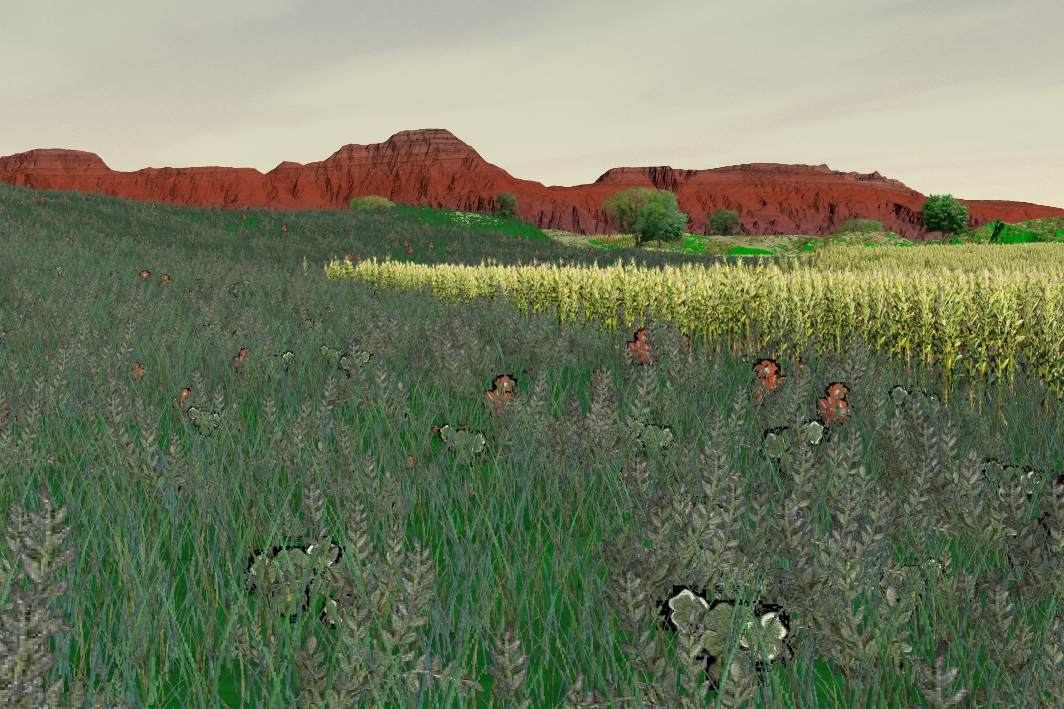
When I started zooming around this series in close I noticed alot of roads and small hills. These roads run throughout the eastern region and are long. The travel from place to place being hundreds of pasang in many cases.
These trails would wind their way through fields of grain, over hills and across through forested lands. They are highly explosed. The most open areas are the hilly areas east and south of Koroba and Tharna.
Venna is a small, exclusive resort city, some
two hundred pasangs north of Ar. It is noted for its baths and its tharlarion
races. Fighting slave of Gor Pg 172
Venna has many small and fine shops, catering to the affluent trade of the well-to-do, who patronize the baths and public villas of the area. Fighting Slave of Gor Pg 204
The three moons were now high. We could hear insects
in the hedged gardens beneath and beyond the balcony. We could see the
lights of Venna, too. The baths were still open. The house of the Mistress
was in the Telluria section, which is in the northwest part of the city,
on a hill. It is the preferred residential section of Venna. The house,
situated as it was, provided us with a lovely panorama of the small city.
Fighting Slave of Gor Pg 201
The report claims they are in winter quarters
at Holmesk, one hundred pasangs south of the Vosk.
Renegades of Gor Pg 189
As rumor has it, Clearchus was a famous brigand of some two centuries
ago who decided to legitimize and regularize his brigandage. He proclaimed
his area of operations a ubarate, proclaimed himself its ubar, and then
proceeded to impose taxes and levy tolls. Interestingly enough, in time,
several cities accorded this ubarate diplomatic recognition, generally
in return for concessions on the taxes and tolls. Finally a large force
of mercenaries, in the hire of the merchant caste, in a campaign that
lasted several months, put an end to the spurious reign of Clearchus,
driving him from the forest and scattering his men....
Players of Gor Pg 100
...I remembered her as I had seen her, in the
swamp forest, south of Ar, with Nar the spider...
Captive of Gor Pg 368
When the men of Ar moved, for example, and whenever possible they would
do so on the great military roads, such as the Viktel Aria, they used
a measured pace, often kept by a drum, and including rests, would each
day cover a calculable distance, usually forty pasangs. At forty-pasang
intervals there would generally, on the military roads, be a fortified
camp, supplied in advance with ample provisions. Some of these camps became
towns. Later some became cities." Mercenaries of Gor Pg 38
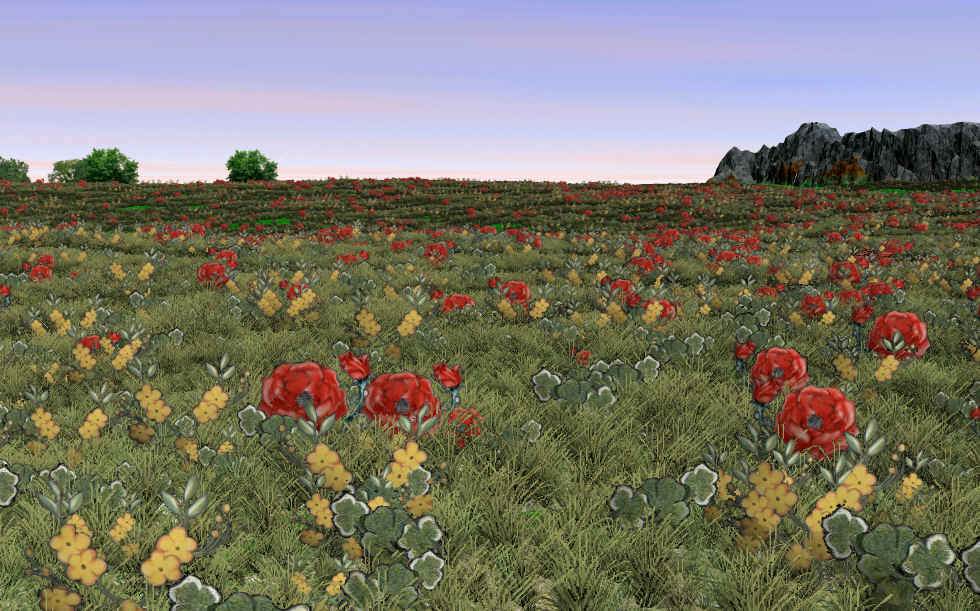
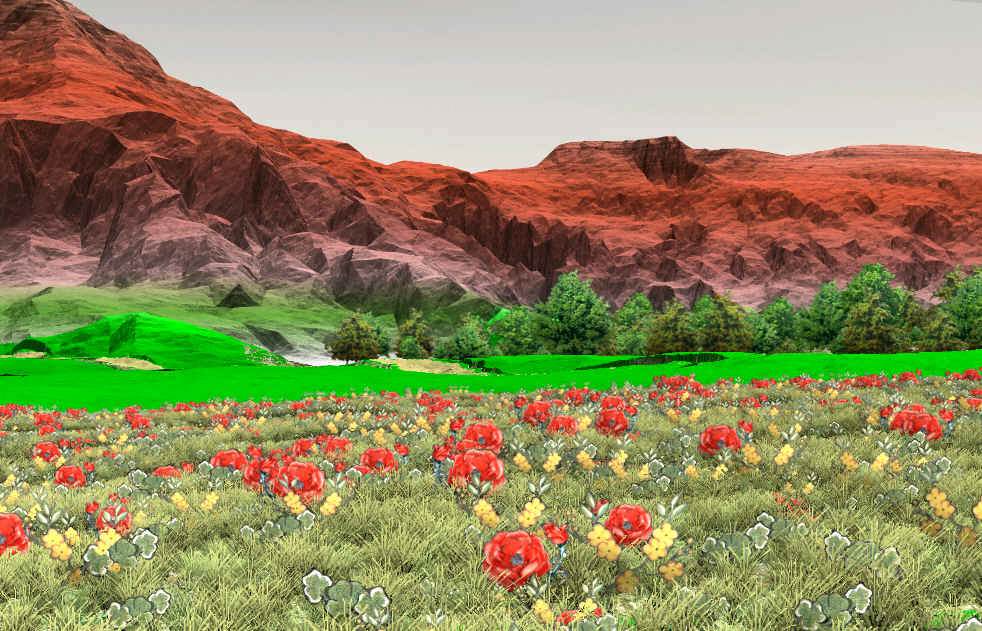
The expression 'Saleria', doubtless owing its
origin to the meadow of Salerius, is used broadly, incidentally, to refer
to the fertile basin territories both north and south of the Olni, the
lands over which the confederation professes to maintain a hegemony. The
meadow of Salerius, thus, lies on the northern bank of the Olni, between
Port Olni and Vonda; the area called Saleria, on the other hand, is, in
effect, the lands controlled by the confederation. Ti, Port Olni and Vonda
lie on the northern bank of the Olni; Lara lies between the Olni and the
Vosk, at their confluence. It is regarded as being of great strategic
importance. It could, if it wished, prevent Olni shipping from reaching
the markets of the Vosk towns, and, similarly, if it wished, prevent shipping
from these same towns from reaching the Olni markets. Overland shipping
in this area, as is generally the case on Gor, is time consuming and costly;
also, it is often dangerous. It is interesting to note that the control
of piracy on the Olni was largely a function of the incorporation of Lara
in the confederation. This made it difficult for the pirate fleets, following
their raids, to descend the Olni and escape into the Vosk....
Fighting Slave of Gor Pg 171-172
The retinue was the betrothal and dowry retinue
of the Lady Sabina of the small merchant polls of Fortress of Saphronicus
bound overland for Ti, of the Four Cities of Saleria, of the Salerian
Confederation....
Slave Girl of Gor Pg 110
...The journey itself, overland and afoot from Fortress of Saphronicus to Ti, would take several days, but it was ceremonially prolonged in order that the four tributary villages of Fortress of Saphronicus might be visited. It is not unusual for a Gorean city to have several villages in its vicinity, these customarily supplying it with meat and produce.... Slave Girl of Gor Pg 111
We then waited about a minute, and I saw several
birds--river gulls--flying north. "Those are Vosk gulls," said Kamchak.
"In the spring, when the ice breaks in the Vosk, they fly north." Nomads
of Gor Pg 137
I set her down on a bed of green clover. Beyond it, some hundred yards
away, I could see the border of a yellow field of Sa-Tarna and a yellow
thicket of Ka-la-na trees....
Tarnsman of Gor Pg 96
Economically, the base of the Gorean life was the free peasant, which
was perhaps the lowest but undoubtedly the most fundamental caste, and
the staple crop was a yellow grain called Sa-Tarna, or Life-Daughter....
Tarnsman of Gor Pg 43
There was a shallow bowl of flowers, scarlet,
large-budded, five-petaled flaminiums, on the small, low table between
us.
Hunters of Gor Pg 154
In the distance, perhaps some forth pasangs away, I saw of set of ridges,
lofty and steep, rearing out of a broad, yellow meadow of talendars, a
delicate, yellow-petaled flower, often woven into garlands by Gorean maidens....
Outlaw of Gor 131
my own brand was the dina; the dina
is a small, lovely, multiply petaled flower, short-stemmed, and blooming
in a turf of green leaves, usually on the slopes of hills, in the northern
temperate zones of Gor; in its budding, though in few other ways, it resembles
a rose; it is an exotic, alien flower; it is also spoken of, in the north,
where it grows most frequently, as the slave flower; ...But perhaps the
dina is spoken of as the slave flower merely because, in the north, it
is, though delicate and beautiful, a reasonably common, unimportant flower;
it is also easily plucked, being defenseless, and can be easily crushed,
overwhelmed and, if one wishes, discarded. Slave Girl of Gor Pg 61- 62
No, the Sardar Range was not the superb natural wilderness that was the
Voltai. Its peaks did not scorn the plains below. Its heights did not
taunt the sky nor, in the cold of the night, defy the stars. In it would
not be heard the cry of tarns and the roar of larls. It was inferior to
the Voltai in both dimension and grandeur. Yet when I looked upon it,
more than the gloriously savage, larl-haunted Voltai, I feared it. Outlaw
of Gor Pg 180
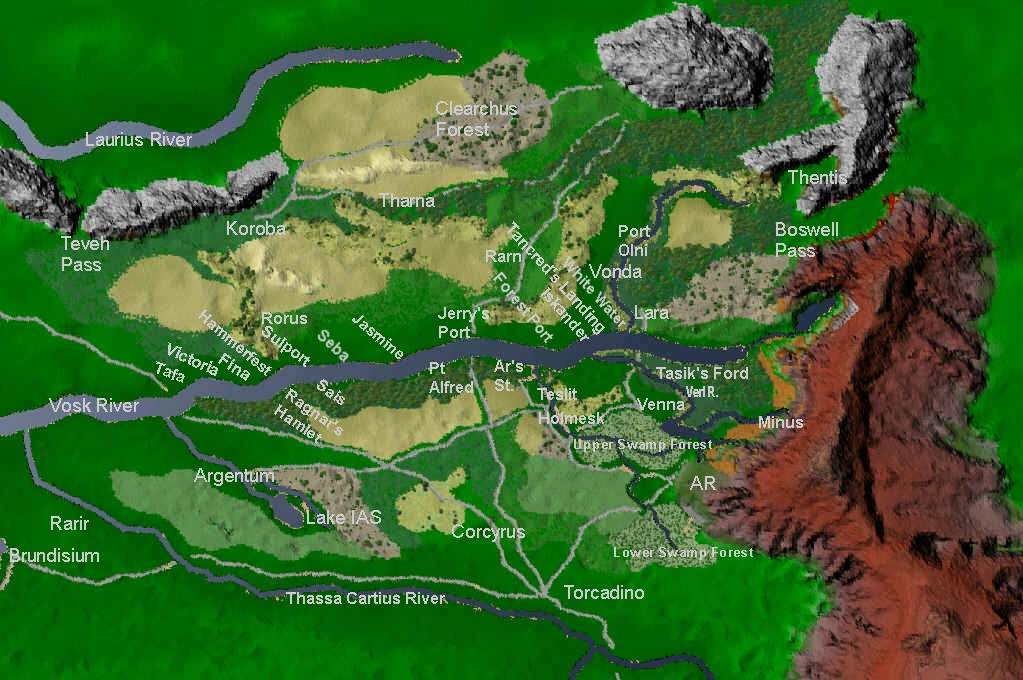
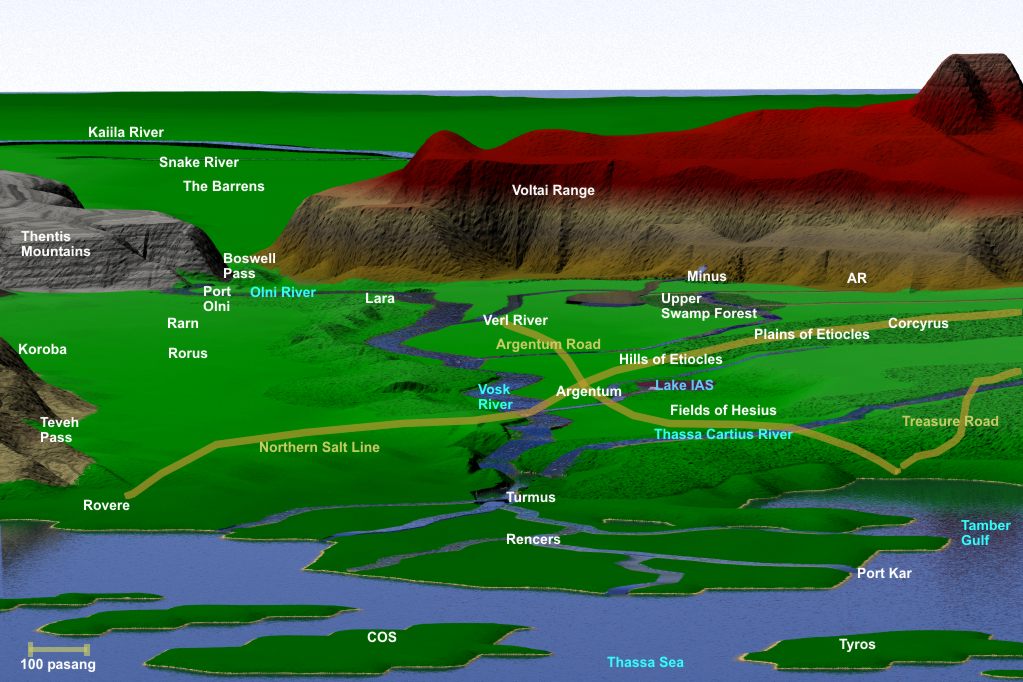
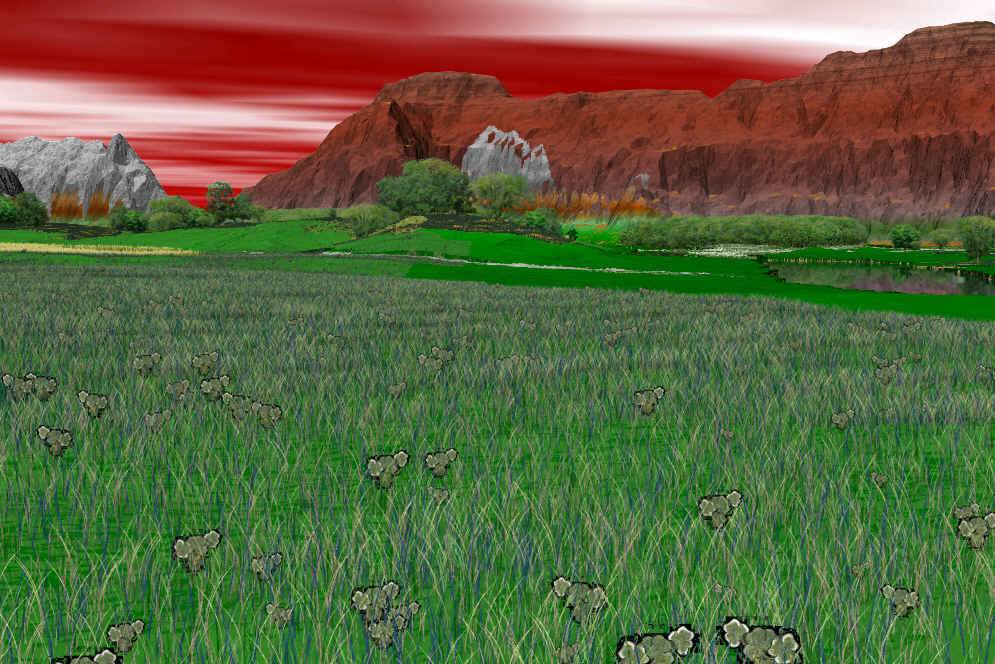
Many of these images have pictures of flowers that ka'reena has created. They are 'grown' into the landscape for the regions. Here you will find dina, talendars, clovers and ferns she has created.
The Boswell pass lies between the Voltai Range and the Thentis Mountains. The pictures to the right show the pass, high above the Vosk river valleys bellow and facing eastward.
"The next town northward is Fort Haskins," I said. This lay at the foot of the Boswell Pass. Originally it had been a trading post, maintained by the Haskins Company, a company of Merchants, primarily at Thentis. A military outpost, flying the banners of Thentis, garrisoned by mercenaries, was later established at the same point. The military and strategic importance of controlling the eastern termination of the Boswell Pass was clear. It was at this time that the place came to be known as Fort Haskins. A fort remains at this point, but the name, generally, is now given to the town which grew up in the vicinity of the fort, primarily to the west and south. The fort itself, incidentally, was twice burned, once by soldiers from Port Olni, before that town joined the Salerian Confederation, and once by marauding Dust Legs, a tribe of the red savages, from the interior of the Barrens. The military significance of the fort has declined with the growth of population in the area and the development of tarn cavalries in Thentis. The fort now serves primarily as a trading post, maintained by the caste of Merchants, from Thentis, an interesting recollection of the origins of the area. Savages of Gor Pg 76-77
Dietrich of Tamburg, of the high city of Tarnburg, some two hundred pasangs to the north and west of Hochburg, both substantially mountain fortresses, both in the more southern and civilized ranges of the Voltai, was well-known to the warriors of Gor. His name was almost a legend. It was he who had won the day on the fields of both Piedmont and Cardonicus, who had led the Forty Days' March, relieving the siege of Talmont, who had effected the crossing of the Issus in 10,122 C.A., in the night evacuation of Keibel Hill, when I had been in Torvaldsland, and who had been the victor in the battles of Rovere, Kargash, Edgington, Teveh Pass, Gordon Heights, and the Plains of Sanchez. His campaigns were studied in all the war schools of the high cities. I knew him from scrolls I had studied years ago in Ko-ro-ba, and from volumes in my library in Port Kar, such as the commentaries of Minicius and the anonymous analyses of "The Diaries," sometimes attributed to the military historian, Carl Commenius, of Argentum, rumored to have once been a mercenary himself. Mercenaries of Gor Pg31-32
'The Priest-Kings,' said my father, 'maintain the Sacred Place in the
Sardar Mountains, a wild vastness into which no man penetrates. The Sacred
Place, to the minds of most men here, is taboo, perilous. Surely none
have returned from those mountains.' Tarnsman of Gor Pg 29-30
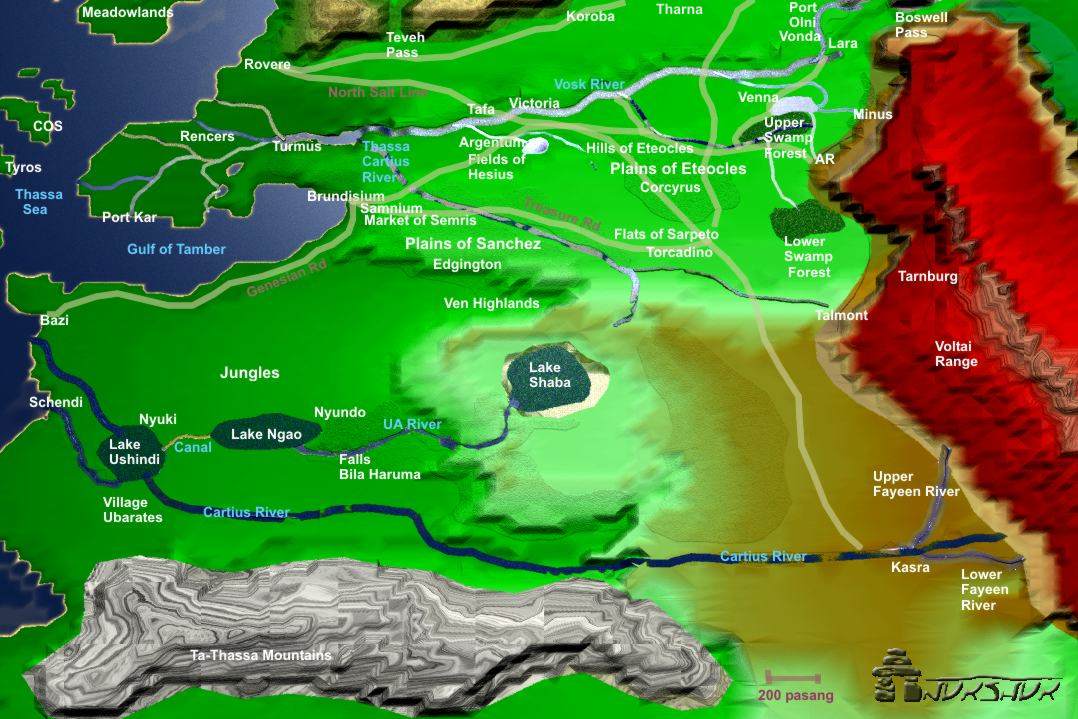
Ar's Station, incidentally, did not exist at the
time of the massing of the horde of Pa-Kur. It was established four years
afterward, as an outpost and trading station on the south bank of the
Vosk. It also commands, in effect, the northern terminus of one of the
great roads, the Viktel Aria, or Ar's Triumph, leading toward Ar....
Rogue of Gor Pg 63
I knew something of the Vosk League. Its headquarters was in the town
of Victoria, on the northern bank of the Vosk, between Fina and Tafa....
Renegades of Gor Pg 346
Ragnar's Hamlet began as a small village and,
from this central nucleus, expanded. Rogue of Gor Pg 61-62
Perhaps Treve has never attacked Thentis because she, too, is a mountain
city, lying in the Mountains of Thentis, or more likely because the men
of Treve respect her tarnsmen almost as much as they do their own.
Priest-Kings of Gor Pg 62
"There are the aqueducts of Torcadino!" said Mincon.
"I see them," I said. The natural wells of Torcadino, originally sufficing for a small population, had, more than a century ago, proved inadequate to furnish sufficient water for an expanding city. Two aqueducts now brought fresh water to Torcadino from more than a hundred pasangs away, one from the Issus, a northwestwardly flowing tributary of the Vosk, and the other from the springs in the Hills of Eteocles, southwest of Corcyrus. The remote termini of both aqueducts were defended by guard stations. The vicinities of the aqueducts themselves are usually patrolled and, of course, engineers and workmen attend regularly to their inspection and repair. These aqueducts are marvelous constructions, actually, having a pitch of as little as a hort for every pasang. Mercenaries of Gor Pg 101-102
The retinue was the betrothal and dowry retinue
of the Lady Sabina of the small merchant polis of Fortress of Saphronicus
bound overland for Ti, of the Four Cities of Saleria, of the Salerian
Confederation. Ti lies on the Olni, a tributary of the Vosk, north of
Tharna.
Slave Girl of Gor Pg 110
Tabuk's Ford receives its name from the fact that
field Tabuk were once accustomed, in their annual migrations, to ford
the Verl tributary of the Vosk in its vicinity. The Verl flows northwestward
into the Vosk. We had crossed the Vosk, on barges, two weeks ago....
Slave Girl of Gor Pg 135
The Olni, for practical purposes, has been freed of river pirates. The
oaths of the league, and the primitive articles pertaining to its first
governance, were sworn, and signed, in the meadow of Salerius, which lies
on the northern bank of the Olni between Port Olni and Vonda."
Fighting Slave of Gor Pg 171
It was near dawn now. The wagon would proceed
east on the Argentum road, reach the Viktel Aria, and turn south. Then,
in time, it would arrive in Ar. Soon I would be enslaved, legally. I would
be, totally, legally, a slave on Gor.
Kajira of Gor Pg 263
The Older Tarl had told me that Thentis is a city famed for its tarn flocks and remote in the mountains from which the city takes its name. Tarnsman of Gor Pg 67
"Our generals did not feel it was necessary," said Ligurious.
"It seems that our first victory, after the seizure of the mines, occurred on the Fields of Hesius," I said.
"Yes," said Ligurious. "Our second occurred on the shores of Lake Ias," I said, "and our third east of the Issus." This was a northwestward-flowing river, tributary to the Vosk, far to the north. "Yes, my Tatrix," said Ligurious. "Now we have been victorious once more," I said, "this time on the Plains of Eteocles." "Yes, my Tatrix," said Ligurious.
"They lie within a hundred pasangs of Corcyrus," I said.
Kajira of Gor Pg 158-159
Tabuk's Ford receives its name from the fact that field Tabuk were once accustomed, in their annual migrations, to ford the Verl tributary of the Vosk in its vicinity. The Verl flows northwestward into the Vosk. We had crossed the Vosk, on barges, two weeks ago. Slave Girl of Gor Pg 135
My thanks to 'autumn NS' for her help in this as well as Karnik.
And Tazmin just because...
Right click 'Save' for the larger images.
Inukshuk 2002 - 2004